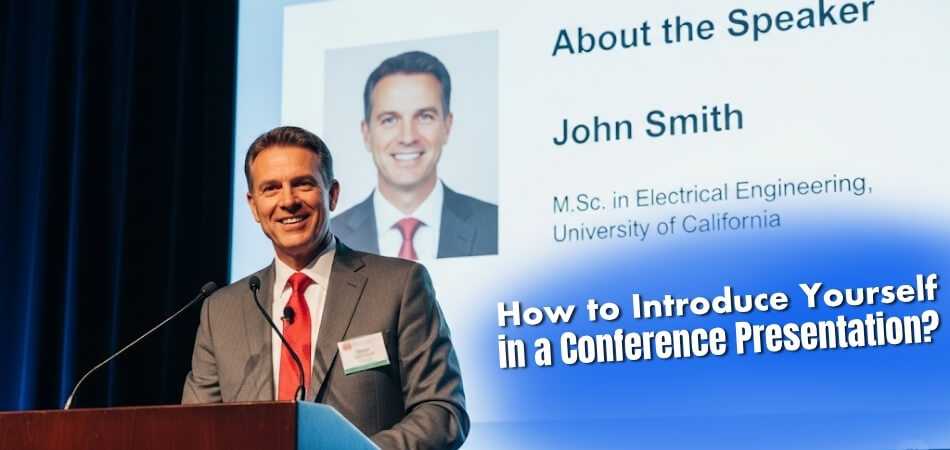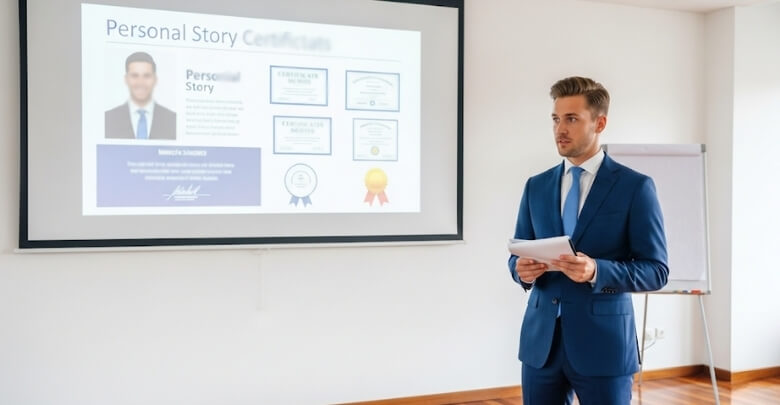Introducing yourself in conference presentations the right way can change everything. It sets the mood, builds trust, and helps people focus on what you’re about to say. Many speakers feel unsure about what to say first, and that’s when they start wondering how to introduce yourself in a conference presentation.
Start with a hook, then say your name and role clearly to introduce yourself in a conference presentation. Explain your link to the topic and what people will learn. Match the event’s tone and speak with confidence. A good intro builds trust and helps people stay focused.
Do you want to know how to do all this in a way that feels natural and smooth? If yes, then keep reading this article because it covers every detail you need. From how to start your speech to how to keep people listening, everything is explained clearly to help you feel more prepared.
How to Introduce Yourself in a Conference Presentation?
It’s normal to feel nervous before speaking at a conference event. But if you know how to introduce yourself well, it becomes much easier. A strong opening helps people listen and trust what you say. Read these simple tips below to make your next introduction great.

Start With a Hook
You should always begin your talk with something that grabs attention fast. Try asking a smart question, sharing a cool fact, or telling a short story. These little tricks help people feel curious and ready to listen to you. For example, say, “Last night, I found a mistake that changed my whole plan.” This makes your talk sound exciting before you even say your name.
Say Who You Are
After getting their attention, clearly tell your name and what you do. It’s best to keep it short, like, “Hi, I’m Riya Das, a junior scientist at TechWorld Labs.” You don’t need to talk about your full career or everything you’ve done. Just give enough to show who you are and why you’re there. People connect better when they know who is speaking to them.
Explain Your Reason
People want to know why you’re the one giving this presentation today. Give one good reason that shows your connection to the topic. For example, say, “I’ve been working on this project for two years straight.” That simple line helps others understand you have real experience to share. They’ll trust your words more because you clearly know what you’re talking about.
Share What’s Coming
Always tell your audience what they will learn from your talk today. You could say, “By the end, you’ll know how to save time using this tool.” This makes people stay focused because they know your talk has real value. You don’t need to give too much detail—just enough to set the direction. When people know what’s coming, they pay better attention from the start.
Match the Event
Some events feel formal, while others are friendly and full of energy. Your introduction should change based on how the event feels overall. For example, a business conference might need a more serious tone than a tech meetup. And if you’re preparing for international events like upcoming conferences in USA, Canada, or any other country, it helps to watch how speakers talk at those events first.
Practice Beforehand
Don’t try to say your whole speech word-for-word like a script. Practice until it sounds natural but still clear and strong. You can talk to a mirror or ask a friend to listen. Try using the same words each time so you remember them. Practicing this way helps you feel confident and calm when you finally stand up to speak in front of others.
Speak With Confidence
Standing straight, smiling, and speaking clearly makes people trust you quickly. Use your hands a little, make eye contact, and pause between points. Don’t say sorry or point out if something goes wrong while speaking. Just continue calmly and stay focused on what you’re saying. People remember speakers who seem relaxed and sure, even if they feel nervous inside during their presentation.
A good introduction helps the audience feel ready to hear your message. If you follow these steps, you’ll speak better and feel more relaxed too. Always remember to be clear, honest, and easy to understand. When you do that, people will enjoy listening to what you say.
Should You Start With Credentials or a Personal Story in Your Conference Presentation?
Starting a conference talk isn’t always easy, but those first few words can make a big difference. Some people open with a personal story, others begin by introducing themselves. What works best? Let’s look at both styles and see which one really grabs attention.
Starting with Credentials
Talking about your background helps the audience know who you are. In academic conferences, people want to see that you know the topic. They listen better when they feel you’re someone they can trust. Saying where you studied or worked can make a strong impression. This style is great when facts and research are very important. Experts in the room expect knowledge before anything else. So, begin with your experience if your audience values proof.
Starting with a Story
Grabbing attention early is easier when you begin with a story. People love to hear stories that they can relate to quickly. This method works well when your crowd wants fresh ideas and real examples. At industry events, personal stories can make your message easy to remember. The audience connects more when it feels real and simple. Just make sure the story matches your topic well. If not, it might confuse the listeners.
Understanding the Audience
Knowing who’s in the room helps you plan your opening better. Are they teachers, workers, or students? Different people expect different things from a speaker. Academic groups want facts, research, and reasons to believe you. Business or industry crowds prefer stories, tips, and personal tricks. When you know your audience, your talk feels more useful to them. Thinking about the people listening always helps you choose the right start.
Mixing Both Styles
You don’t always have to choose just one way to begin. A short story followed by your background can work really well. Or you can start with a quick fact and then tell a story. This keeps things interesting while showing you know what you’re saying. A mix also helps when the audience is from different backgrounds. Just remember not to make your opening too long or confusing. Keep it smooth and clear from the start.
What Works Best
Choosing the best way to start depends on the type of event. There’s no rule that says one way is always better. If you’re unsure, pick the one that feels right to you. You can also watch other speakers and see what works well. Try both styles during practice and ask friends what they think. The best opening is the one that keeps people listening. So be ready to change based on who’s watching.
Both story and background styles work well in different places. Picking the right start depends on who you’re talking to. Always keep your talk clear, short, and easy to follow. Practice different styles and find what feels right for you.
How to Connect Your Introduction to Your Conference Presentation Topic?
It’s important to start your talk in a way that feels natural. People enjoy listening when they feel a personal connection to the speaker. A good introduction can grab attention and make your message clear. Let’s explore how you can smoothly connect your introduction to your main topic.
Use a Simple Story
Begin with a short story that matches the topic of your talk. A quick example from everyday life can help your audience feel comfortable. They don’t need to know every detail, just enough to connect. Once they understand the story, it’s easier to move into your subject. Keep it friendly and real, like talking with a friend. This way, people pay more attention and follow what you’re saying next.
Explain the Importance
Your audience needs to know why your topic is worth their time. Let them see how your talk might help or teach them something useful. Say it in a clear and honest way without sounding too serious. It’s okay to keep things light while still being meaningful. If people see the value early, they’ll want to learn more. That’s how you keep them listening from start to finish.
Talk About Your Work
Sometimes, your topic comes from something you’ve been working on. You can share a small part of that work so your audience understands your point. For example, if it’s based on research, just mention how you began. Later in the full talk, you might explain more when you write methodology for a conference paper. For now, just help people see why the topic matters to you and why it should matter to them.
Keep Language Easy
Many people don’t like talks that are hard to follow or too long. Make your words simple and your sentences short so everyone understands. Use examples people know and skip the difficult terms or deep facts. This helps the audience stay with you without feeling lost or bored. When your message is clear, your talk becomes more fun and easier to remember.
Make It Flow Naturally
Don’t let your introduction and main topic feel like two separate talks. Try to end your intro with something that smoothly connects to your next point. That makes it easier for people to follow your ideas without confusion. The switch from intro to topic should feel soft, not sudden. If the flow is smooth, your whole presentation will feel better and more complete.
A good start helps your audience stay interested in your full talk. Make sure your words are simple and connect with real-life examples. Keep the mood light while still sharing something that matters. That way, people will enjoy and remember what you said.
How Long Should Your Introduction Be in a Conference Talk?
Standing in front of a crowd and starting your talk can feel exciting. The first few minutes are your chance to get everyone’s attention. People decide quickly if they want to keep listening. So, making your introduction work really matters.
- Start Strong: Begin with something interesting or surprising that makes people want to hear more from you.
- Know Your Time: Plan how long your full talk is so you can keep the intro short.
- Stick to the Point: Don’t talk about too many things at once—stay focused on one main idea.
- Show Confidence: Speak clearly and with a smile to help the audience feel relaxed and ready.
- Keep It Simple: Use easy words and short sentences so everyone can understand what you’re saying.
- Add a Hook: Use a small story, fun fact, or question to catch interest right away.
- Say Why It Matters: Let people know why your topic is important without taking too long to explain.
- Avoid Long Backgrounds: Don’t spend too much time talking about yourself—just say the most important parts.
- Practice Beforehand: Try your intro a few times at home so it feels natural and smooth.
- Use Your Voice Well: Change your tone a little to keep it lively and not boring.
- Make Eye Contact: Look at different people in the room so they feel included and connected.
- End with Purpose: Finish your intro by leading into the main topic so it all flows well.
Your introduction should be short but still make people interested in listening more. With the right planning, you can keep it clear and fun. A strong start makes the whole talk feel better. Practice helps you do it well.
Common Mistakes to Avoid When Introducing Yourself at a Conference
When you speak at a conference, your first words can really set the tone. A clear and friendly start helps others feel more connected to you. But small mistakes can make things awkward or confusing. Let’s look at what to avoid right away.
Talking Too Much
Many people try to explain everything in the first few minutes. This often leads to long stories that don’t really help the main talk. If you keep speaking without a clear point, your audience might lose interest. It’s better to stay on track with short and clear points. You don’t need to say everything about yourself at the start. Save some things for later in the presentation to keep people interested.
Acting Too Shy
Some people worry too much about sounding proud, so they say very little. While being humble is nice, it can make you seem unsure or unprepared. The goal is to share just enough about yourself to show you belong there. When you speak with confidence but not too much pride, people respect your words more. Don’t hold back too much, or others may not take your talk seriously.
Sounding Too Proud
Bragging can turn people off quickly, even if your work is impressive. When you only talk about awards or big titles, your audience might lose interest. It’s okay to share your experience, but mix it with real interest in the topic. Keep the focus on what people will learn, not just what you’ve done. A balanced tone shows both your skill and your respect for the listeners.
Missing the Topic
Your introduction should clearly connect to what you’re about to present. If you forget to link yourself to your topic, people may get confused. This can make your talk feel disconnected or random. Try to say how your experience or interest connects with the subject. One common pitfall is sounding too rehearsed or vague when you first introduce yourself at a conference, which can make it harder to establish rapport with the audience.
Using Complex Words
Complicated words can confuse people and create a distance between you and them. It’s tempting to sound smart, but clear and simple language works better. Use words most people hear in everyday life. This helps the audience focus on what you mean, not just how you say it. A friendly and easy tone always makes the start of your talk feel more welcoming and easier to follow.
Little mistakes in your intro can hurt the whole talk later on. Try to keep your tone simple, honest, and connected to your topic. Speak like you’re talking to someone you know well. That way, people will enjoy listening from beginning to end.
Commonly Asked Questions
It’s normal to have questions before giving a presentation at a conference. You might wonder how to speak clearly, how to look confident, or what to include in your introduction. These common questions can help you feel more ready and calm. Below are some simple answers that can guide you through it.
What If You Forget What to Say?
If you forget your words, take a small pause and breathe. It’s okay to stop for a moment and collect your thoughts. Don’t say “I forgot,” just pick up where you left off. The audience will understand, and most won’t even notice.
How Do You Start If You’re Feeling Nervous?
Take a deep breath before you speak and smile at the audience. Start with your opening line that you practiced earlier. Speaking slowly and clearly helps calm your mind. Once you begin, your nerves usually go away in a minute.
Should You Use Slides During Your Introduction?
It’s fine to use one slide with your name and role if you want. But don’t fill it with too much information. The audience will listen to you more if they’re not reading everything from the screen. Keep your intro slide simple and clear.
What Should You Wear for the Talk?
Wear clothes that match the type of event you’re attending. If the event feels formal, dress nicely and neatly. For friendly events, smart casual clothes are usually fine. Feeling comfortable in your clothes helps you feel more confident as well.
Can You Use Humor in Your Introduction?
Yes, you can use a little humor if it feels natural to you. Just keep it light and friendly, not too silly or off-topic. A small joke or funny line can help people relax. But only use humor if you’re sure it fits the mood.
How Do You Make People Listen to You?
Speak clearly and with energy so your voice sounds interesting. Look at the people in the room, not just your notes. Say something useful early in your talk so people know it’s worth listening to. If you sound sure, others will pay attention.
Should You Ask a Question While Introducing Yourself?
You can ask a short and simple question to get people thinking. Make sure it connects to your topic and isn’t too hard to answer. Even if no one answers out loud, it still helps grab attention. Asking a question makes your talk feel more like a conversation.
How Do You Know If Your Introduction Is Too Long?
If it takes more than a few minutes, it might be too long. Try to time yourself during practice to check how long it takes. If you say the main points clearly and quickly, that’s enough. The rest of your time should focus on the main talk.
Can You Mention Hobbies or Personal Interests?
You can share a fun detail if it connects with your topic. For example, if your hobby helped you learn something useful, it fits well. But don’t spend too much time talking about hobbies. Keep it short so your talk stays focused.
What If The Audience Looks Bored?
Sometimes people look serious even when they’re listening. Don’t let it make you nervous. Try to keep your voice clear and lively, and add a smile. A good speaker stays calm and keeps going, even if the crowd looks quiet.
End Note
Making a good first impression is not hard if you plan it well. Speak clearly, be honest, and match your tone to the event. A short story, your name, and a clear reason for speaking are all you need to make people listen. With the right mix of words and energy, you now know how to introduce yourself in a conference presentation. Keep it simple, real, and connected to your main topic.
To wrap it up, remember to stay calm, smile, and use words everyone understands. Practice your intro a few times so it sounds smooth and confident. Don’t rush, and don’t worry about small mistakes while talking. Most importantly, enjoy the moment and share your ideas proudly. Good luck with your next presentation—you’ve got this!







